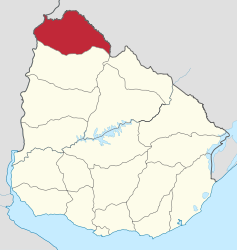Artigas Department
| Artigas | |||
|---|---|---|---|
| Symbols | |||
|
|||
| Basic data | |||
| Country | Uruguay | ||
| Capital | Artigas | ||
| surface | 11,928 km² | ||
| Residents | 73,378 (2011) | ||
| density | 6.2 inhabitants per km² | ||
| ISO 3166-2 | UY-AR | ||
| Website | www.artigas.gub.uy (Spanish) | ||
| politics | |||
| Intendant | Patricia Ayala | ||
| Political party | Front Amplio | ||
Coordinates: 30 ° 37 ′ S , 56 ° 57 ′ W
Artigas is one of the departments of Uruguay .
geography
Location and landscape
The department, which covers an area of 11,928 km², is located in the far northwest of the country on the border with Argentina and Brazil . The triangle in the northwest of the department , at the mouth of the border river to Brazil, the Río Cuareim , into the Río Uruguay , the border river to Argentina, is called Bella Unión (Spanish for beautiful union). There is the controversial river island Isla Brasilera . The capital of the department is Artigas . Other important urban settlements are Bella Unión , Tomás Gomensoro , Baltasar Brum , Las Piedras and Pintadito .
Natural resources
In Artigas, in the eastern area of the department, agate and amethyst deposits are found on the Arroyo Tres Cruces , on the Arroyo Cuaró , on the Arroyo Catalán Grande , on the Arroyo Catalán Chico , in the Cuchilla de Belén , in the Cuchilla Catalán , in the Cuchilla Yacaré Cururú and at La Bolsa .
history
Artigas was founded in October 1884 from part of Salto as a new province.
population
While the total population of the department was 78,019 in 2004, the 2011 census only counted 73,378 inhabitants. More than half of the department's population lives in the capital Artigas (40,658 inhabitants). (Status: Census 2011)
Infrastructure
education
Artigas has a total of eleven secondary schools ( Liceos ), in which 6,551 students are taught by 503 teachers. Four of these liceos are located in the department capital. The oldest Liceo in the department is the Liceo Nº 1 Departamental , which was established in 1913 and is located in the Barrio Centro . (As of December 2008)
traffic
In the area of the department there is a connection to the air traffic with the airport Artigas . A railway line from the direction of Salto runs through the department , which at Baltasar Brum divides into the directions of the capital city and Bella Unión . Furthermore, the following roads cross the department in any case: Ruta 3 , Ruta 4 , Ruta 30 .
economy
Artigas used to be one of the most developed departments in the country. His wealth was based primarily on sugar production and growing vegetables . Today, however, a serious crisis has emerged that has transformed the department into one of the most troubled regions of Uruguay.
politics
Patricia Ayala from the Frente Amplio holds the leading position of the executive branch of the department, the office of the intendente .
Web links
- Official website of the Intendencia de Artigas
- Artigas in the Enciclopedia Geografica del Uruguay (Spanish)
Individual evidence
- ↑ Ulises Rubens Grub : Atlas geografico de la República Oriental del Uruguay, Montevideo 1980, p. 35
- ↑ Statistical data of the 2011 census ( memento of the original from September 27, 2015 in the Internet Archive ) Info: The archive link was inserted automatically and has not yet been checked. Please check the original and archive link according to the instructions and then remove this notice. of the Instituto Nacional de Estadística de Uruguay , accessed on August 29, 2012 (XLS file; 25 kB)
- ↑ Statistical data from the Instituto Nacional de Estadística de Uruguay
- ↑ Liceos del Uruguay (Spanish) (PDF; 7.3 MB), accessed on February 29, 2012
- ↑ Ulises Rubens Grub : Atlas geografico de la República Oriental del Uruguay, Montevideo 1980, p. 37
- ↑ Ulises Rubens Grub : Atlas geografico de la República Oriental del Uruguay, Montevideo 1980, p. 39



